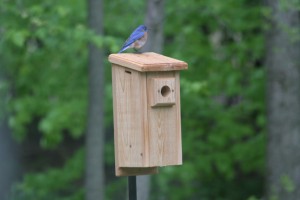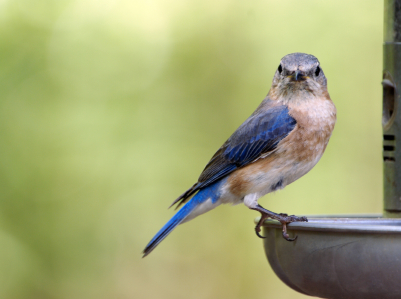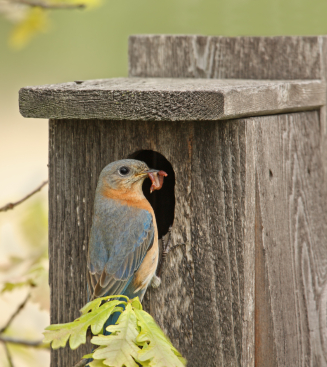-
Blue Bird Houses with Vacancies
As the days become longer, a birds’ instinct to nest becomes stronger. Regardless of temperature you know it’s a sure sign of spring when birds are scurrying and flitting about with twigs, straw or grasses in their beaks.
Today I was thrilled to witness such behavior by a male bluebird. I had cleaned out the old nests a few weeks ago and was afraid I’d chased away my little blue friends. Nope…they’re here, happy and getting ready for babies! This little guy was working hard, carrying piece after piece of pine straw into the house. Guess he has a pretty woman to impress!
The two blue bird houses in my yard are in close proximity. Although bluebirds are very territorial – which is why they say houses should be placed 100 feet apart, this close placement (10-15 feet) helps to alleviate competition from other birds for the coveted nest box.
-
Bluebird House Wars
So You’d Like to Attract Bluebirds?
One of the favorite of all songbirds is the bluebird. Their gentle disposition, and sense of family are amazing, not to mention their color and song. Placing a bluebird house in your yard is a great way to start, but may not do the trick in and of itself.
Fierce competition for nest boxes exists between house sparrows (a non-native species) and our beloved bluebirds. House sparrows are known to kill babies and adult bluebirds alike. One way to help alleviate the fighting, is to place an additional bluebird house about 10-15 feet away from the first one.
Adding a bird bath will not only help attract bluebirds, but other wonderful songbirds as well. The all-time favorite treat for bluebirds has got to be live mealworms! They are coveted for the high protein content, and most birds will gorge on them…literally eating you out of house and home! The way to exclude these little piggies is to feed meal worms in a bluebird feeder. There are very few birds, besides the bluebird, who will use this type of feeder – having to fly through a hole to reach the prize inside.
Bluebird babies are absolutely irresistible, and if you’re lucky enough to witness two broods in the same season, you’ll see the young from the first brood help mom and dad feed the new babies. Whether you choose a wooden bluebird house, or a recycled plastic one, pay close attention to placement – approximately 5-6 feet high, and in an open area. If you pole-mount the house, it’s best to use a baffle below it to thwart predators. A portal protector over the entrance will also help to ensure a successful brood.
Happy Birding!
-
Time to Clean Out & Repair Bluebird Houses
If you have the dreaded spring cleaning blues, just step outside and switch to spring cleaning your bluebird houses. Now’s the time when males start trying to lure females to the best, and most beautiful house in which they’ll raise their brood.
Clean out old nests, and discard the nest materials away from the house so as not to attract predators. It’s best to scrub the inside with a mild bleach solution as well, (1:10) to kill any infestations, bacteria or molds. Rinse well and let air dry before putting the house back.
Wooden bluebird houses may appear rough around the edges, especially at the entrance…a usual sign of squirrel damage. Don’t fret though, the house is likely still usable. Just add a metal portal, or protector over the existing entrance. They’re inexpensive and work well to repair bluebird houses.
If you’ve just put up your first bluebird house, and are hoping to attract these wonderful birds – try adding live meal worms to your feeding regimen. They really do magically attract bluebirds. A Bird bath with fresh water is helpful too. Our eastern bluebirds braved the harsh winter here in North Georgia as the heated baths, suet and live worms kept them fat and happy. Just know that when feeding live worms, most birds will literally eat you out of house and home, which is why a bluebird feeder works best. The bird must pass through an entrance hole to get the worms. Very few birds, besides bluebirds will do this.
Happy Spring and Happy Birding!



